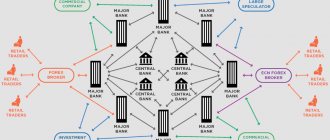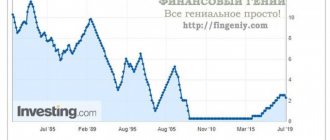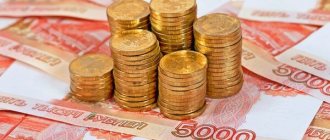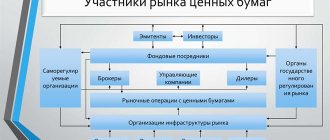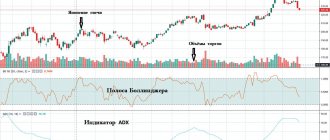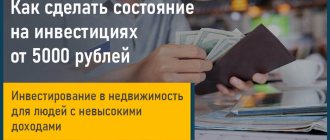Lazy Investor Blog > Stock Exchange
Default on debt securities is an unpleasant event that any investor would like to avoid. Despite the fact that bonds are one of the most reliable and conservative investment instruments, no one is completely insured against the financial insolvency of the issuer.
The existing real risk for the portfolio deserves a separate article. In this article you will learn:
- What is a bond default: signs and consequences;
- Which bonds are at risk of default and what are its signs;
- Recommendations for private investors on minimizing the risk of default.
What is a bond default in simple words?
Default (from the English “Default” - failure to fulfill obligations) is the fact of recognition of the borrower’s insolvency to service the debt.
Difficulties in paying off debt obligations can occur both for an ordinary business and for the state, and even for a simple individual. No one is immune from such problems. Sometimes the largest companies in the world find themselves on the verge of bankruptcy.
Bonds belong to the class of debt securities. Investors act as creditors to the issuer. This is convenient for both parties. A comfortable relationship is created between the two parties to the transaction.
Let us remind you who can issue bonds:
- Commercial companies (such issues are called corporate). Released by Russian companies. On average, the rate of return on them is from 6% to 9%. For example, VTB, Gazprom, Sberbank, Russian Railways, LSR, PIK;
- Municipal districts (subfederal). Issued by cities and regions. For example, Moscow and the Moscow region. On average, income is 1-2% higher relative to the key interest rate;
- State (government bonds). Issued by the state, the most popular and liquid. Their full name is “Federal Loan Bonds” (OFZ) or simply government bonds;
A bond default is the issuer's refusal to pay the debt for more than 10 business days.
Trading of this bond issue on the stock exchange is terminated after the issuer is declared insolvent. This is worth remembering for investors who want to quickly sell problematic securities, even taking into account their strong drawdown.
In the first days of non-payment (up to 10 days), the default is considered technical. In other words: there is hope that the non-payment is due to some difficulties in transferring money. Therefore, the issuer is given time to repay the debt. The chances of payment are 50/50; only insiders can know such information. Ordinary investors can only wait.
A technical default is the issuer's refusal to pay a debt within the first 10 days.
Let us recall that the issuer’s responsibilities include two components: to pay the face value of the securities and to pay interest on them. Some issues specify the obligations under the offer. The company is also obliged to comply with them.
If the company experiences even a technical default, this will greatly damage its reputation. In the future, she will be able to borrow money at higher interest rates, and there will be significantly fewer people willing to invest. High interest rates on debt service will create problems for business.
Most investors will prefer a stable business. The corporate bond market is large, so there is plenty to invest in.
Note Default may be declared on individual bond issues. Therefore, not all creditors may suffer in the event of problems.
- Default - what is it;
Junk Bonds: History
The high-yield bond segment began to develop in the 70s in the United States, and its formation is associated with financier Michael Milken, known as the king of junk bonds. Then his activities were found to be in violation of the law, after which Michael no longer has the right to work in this market. At the same time, in the 70s, it brought billions of profits to clients. Due to the fact that in the high-risk debt market, which was bypassed by serious companies, I found good investment opportunities.
Interestingly, the high-yield bond vehicle has contributed to the development of many sectors that appear to be resilient in the US economy today. We are talking about the film industry, telecom. Today in the US corporate bond market, about 25% are classified as VDOs. Deutsche Bank conducted a study according to which over ten years the profitability of the VDO segment in the United States was 95%, while the S&P 500 index grew by 106%.
It turns out that the more conservative debt segment in terms of profitability has approached the stock market segment. Although there can be a lot of discussion about what exactly is profitable, investing in stocks or bonds.
What should an investor do if a default occurs?
What rights do investors have if a bond defaults? According to Article 395 and Article 450 of the Civil Code of the Russian Federation, the owner of the debt has the right to demand:
- Face value of the paper;
- Interest on coupons on the payment date;
2.1. Positive scenarios
1 The issuer will pay interest and face value (if this is the maturity date) within 10 days. This is the best development option: investors will receive money with interest. There is no need for further red tape. Everyone is happy. The issuer rating will suffer relatively little.
2 The issuer will offer holders to restructure the debt. For example, at a higher interest rate and with a different repayment date. It may differ significantly from what was previously stated.
Another common option is to partially pay off the debt on this issue, and issue the rest at a different interest rate and with a different expiration date. They may offer to convert debt securities into equity securities, that is, offer shares.
In order to approve the proposal from the issuer, approval of 75% of the holders + 1 bond at the general meeting (OSVO) is required. For a minority shareholder, such a scenario practically means that he will be faced with the fact of making a decision: to restructure or not.
After 10 days, trading in the bonds is terminated. Now the holders of these bonds have only one chance to get their money back: through the courts.
2.2. Negative scenarios
Apply to the court. In pre-trial order, you can send a claim to the issuer, where you need to reflect:
- Amount of debt;
- A document from a broker confirming the fact of ownership of bonds;
- A financial statement from the brokerage account, which would reflect the fact of no payment;
If, after three months, the bondholder’s demands have not been satisfied in pre-trial proceedings, then you can go to court with a statement of claim.
To initiate bankruptcy proceedings, the amount of debt must exceed 100,000 rubles. Such a statement is most often organized by large debt holders. There is no point in doing this for the average investor. It is enough to simply apply to the court.
Investors can familiarize themselves with their rights in Art. 134 “The order of satisfaction of creditors’ claims.”
Long after the sale of the issuer's property, the investor has the right to count on part of the compensation. But as practice shows, this amount rarely exceeds 20% of the required. Such a small percentage of return is due to the fact that other creditors and costs are satisfied first.
The order of expenses is as follows:
- Court expenses;
- Remuneration of employees;
- Operating fees;
But that is not all. The following are in order:
- Obligations to the state (taxes, contributions to insurance funds);
- Banks that issued loans to the company secured by property;
And only now is it the turn of bondholders.
conclusions
Issuers of bonds trading in this mode found themselves in a difficult financial situation. Sometimes companies restore their creditworthiness after a default, sometimes they don’t and cease operations. The restoration of activity does not always occur without losses for investors.
But if you remain or become the owner of defaulted bonds, the following can be said with certainty. The procedures for both financial recovery and liquidation are very lengthy. It may take up to five years before the creditor receives payment from the liquidation of the company. The same goes for financial recovery, which is also not necessarily successful.
Thus, the D-Bond regime may be the last tool to return at least part of the investment - to sell securities to those who are willing to play the long game and at huge risk.
Happy investment.
Share
Published 06/28/2018 Yours. You can also read in the Bonds section.
Bond coupon
Bond risks
How an Investor Can Avoid Bond Default
The most important advice that can be given to investors: if possible, it is better to get rid of problem debt securities in advance, since in case of problems it is unlikely that you will be able to get all the money back. Even to return part of the funds will take a long time, which is not worth the nerves or effort to study your rights. Small investors are the least protected, therefore they receive payments last. They also have minimal information about the actual state of affairs.
At the first sign of serious problems for the issuer, the easiest option would be to simply sell it at the market price. The cost can drop to around 20-50% of the face value. Yes, these are considerable losses, but you receive this money here and now with a guarantee.
Is it possible to avoid default on bonds? If you answer “no,” it will be a sweet lie. Even the most reliable companies can have unexpected problems. But we can minimize the risk of losing money when investing in bonds if we follow the following tips.
3.1. Analysis of fundamental indicators
The very first piece of advice for an investor is to study fundamentals. First of all, we are interested in the debt burden and profit dynamics. If in recent years the debt has been growing steadily, but there is no profit, then the risks of non-payment increase significantly. You can only take out such a bond if it offers a substantial risk premium (high coupon yield).
The main multipliers are:
- Debt/EBITDA (no more than 5);
- EV/EBITDA (no more than 7);
Unfortunately, some data in the reporting may be partially manipulated. This is a particularly acute issue for small businesses, where control by auditors (if any) is not as high quality. Therefore, even after studying in detail all the business indicators, it is not a fact that this will turn out to be a true reflection of the current state of affairs.
Ordinary investors are unlikely to be interested in studying the company's reports. Therefore, most people trust the opinion of analysts. It is better for beginners not to get involved with the securities of small companies if nothing is known about their real state of affairs. Their risks are always higher than those of large ones.
Better a crane in the hands than a bird in the sky.
Should we chase high bond yields? Holders of junk bonds can make significant profits if companies can dig themselves out of debt.
Everyone has their own approach to taking risks. Some people would rather have 6% per annum with a guarantee than 12% with risks.
- Fundamental analysis - what is it;
- How to choose undervalued stocks based on multiples;
- Main macroeconomic indicators;
- How to choose OFZ for a beginner;
- FAQ on OFZ;
3.2. Credit rating
If the issuer is large enough, then it has a credit rating. This indicator is assigned by rating agencies. There are not so many large issuers on the Russian market. They are all quite reliable. We can say that there is somewhere around a 99% probability that they will fulfill their obligations under the bonds without any delays or defaults.
The risk of 1% is insignificant, especially since the yield on them is higher than the key interest rate and deposit rates. Therefore, for ordinary investors, lending to these companies in most cases is a very profitable investment.
3.3. We choose large and reliable companies
Invest only in reliable bonds. In our country, the most stable are OFZ (government bonds). Based on their profitability, the risk premium of other companies is calculated.
For example, if you can get an average annual income from OFZs of 5%, then is it worth buying bonds of some company (even a large one) at the same 5%? The answer is obvious - it’s not worth it. Firstly, OFZ risks are the smallest. And, secondly, government bonds are much more liquid.
Investors always compare the return and risk of the issuer. They estimate the size of the risk premium and the probability of default on the bond. The stock market has already calculated these ratios. If the price of a bond costs 50% of its face value, then the holders do not expect anything good from this company.
In the debt securities market, profitability and risk are strictly linked by the following ratio: the higher the risk, the greater the potential profit.
For ordinary investors, you should not try to outplay everyone and invest in issuers with a yield exceeding 3 OFZ rates. For example, if you can get 5% from OFZs, then issues with a yield above 15% can be classified as risky securities. But “risky” does not mean that they will default. The chances of bankruptcy are small, but they are already more than 1%.
Also, do not forget about the taxation of coupon income that exceeds the key rate of the Central Bank + 5%. For example, if the rate is 5%, then if the return is above 10%, 30% tax will be levied on excess profits.
- Profitability and risks of the investment portfolio;
- Yield curve;
3.4. Diversification of the securities portfolio
Buy bonds from different companies. You should not invest all your money in one, especially if the issuer has problems.
Compose a portfolio of bonds, including at least 5-10 issuers. You can allocate 50% to the OFZ share to significantly reduce risks.
- Portfolio diversification rules;
- Investment portfolio of securities - detailed description;
- Portfolio rebalancing;
- How to create an investment portfolio;
- The principle of building a securities portfolio for beginners - a guide;
There is also the option of simply buying a bond ETF. This is a ready-made solution from many issues for the investor. The following funds are represented on the Russian market:
- SBRB - a fund from Sberbank with corporate bonds;
- SBGB - a fund from Sberbank with OFZ;
- VTBB - a fund from VTB with a set of bonds (probably a mixture of OFZ and commercial bonds);
- FXRU, RUSB, SBCB - a fund of Russian Eurobonds without hedging the ruble; if the dollar grows, the fund will grow by the same amount;
- FXRB - the same as FXRU, but with hedging against fluctuations in the ruble exchange rate;
The disadvantage of such funds is the high commission. The investor pays a 1% commission when the bond yield is 5-7%.
- ETF funds - questions and answers;
- ETF yield on the Moscow Exchange;
- Comparison of ETFs and mutual funds - similarities and differences;
- What is more profitable: buy ETFs or shares;
What are the features of the D-bond regime?
As mentioned above, the d-bond regime limits some trading options. Although the main functionality works. Bidding takes place through (as usual) a counter auction.
Only the following are allowed:
- market orders (without price indication);
- limit orders (with price indication).
All other bids, such as iceberg bids, closing period auction bids, are rejected.
There are also no opening and closing auctions.
There is also a mode of negotiated transactions (RPS d-bonds), which allows you to send applications to a specific trading participant and wait for a counter application from him on the same conditions to complete the transaction.
